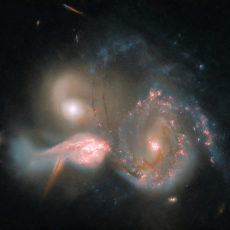
30 Doradus may look like a cosmic tarantula to some, but it’s actually the largest and brightest region of star formation in the local group of galaxies. This Hubble image shows a sparkling circular, wreath-like area of red, orange, beige, brown, and green clouds with many wisps and filaments.

In the center of this cosmic structure is a dark cavity filled with hundreds of sparkling, blue stars. What you’ll notice is that the stars are not evenly distributed, as more exist on the right half of the image. There are also some blue stars that also appear on top of the surrounding, wispy clouds.
- Interactive model – Inspire kids to build a representation of the Earth, Sun and Moon in orbit with this LEGO Technic Planet Earth and Moon in Orbit...
- Educational space toy – Kids can turn the crank to see how the Earth and the Moon orbit around the Sun
- Includes months and moon phases – This solar system toy includes printed details, like the month and moon phases to help kids see how the Earth’s...
The chemical composition of 30 Doradus is different from most of the nebulas found in the Milky Way. Instead it represents the conditions in our galaxy that existed several billion years ago when stars were forming at a much faster pace than astronomers see today,” said NASA.













